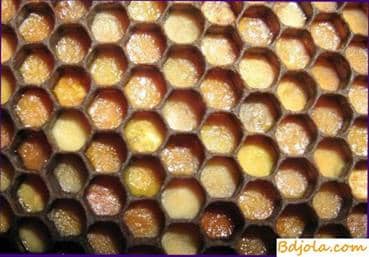Aging of honeycombs

The newly constructed cell of the nest frames has a white or light yellow color. As the number of generations of larvae grows in cells in cells, the cells gradually grow old. Its color becomes light brown, dark brown, and, finally, almost black.
The weight of the honeycomb increases from 140 … 150 to 300 … 500 g. At the same time, the weight of the honeycomb increases mainly due to non-wax impurities (the remnants of cobweb cocoons and larval skins of larvae, lumps of feces, etc.).
As the honeycomb grows older, the capacity of the bee cells decreases significantly (up to 88% of the original volume), the honeycomb hardens and its thermal conductivity decreases sharply. So, if the heat conductivity of freshly made honeycomb is taken as 100%, then after 1 … 2 generations of bees, it will amount to 61.3%, 4 … 6 generations – 38.5, and after 12 … 14 generations of bees heat conduction the honeycomb will decrease to 23.3%.
The ability to correctly determine the age of a honeycomb is of great importance in the practice of beekeeping. Thus, the presence in the nest of too old honeycombs will lead to the reduction of the bees that are excreted in them, to promote the spread of infectious diseases, the large expenditure of labor by the worker bees on the cleaning of the cells. On the other hand, it is impossible to leave honeycomb in the center of the nest for winter or early spring, in which no bees were taken out at all. Such honeycombs will be too cold, and the uterus will not lay eggs in them. They are practically subject to obligatory culling of the honeycomb (even serviceable ones), if 10 … 12 generations of bees have already emerged in them, that is, no more than after a two-year stay in the center of the nest.
To determine the age of the cell by its external characteristics, the following table is given.
1 The overall color of
2 Color honeycomb from white to light brown.
3 The color of the honeycomb is white or light yellow. At the bottom of the cells there are no lumps of feces
– The bees did not appear at all.
4 The color of the honeycomb is light brown, the bottoms are transparent, slightly yellowish. In one, two corners of cells visible dark lumps of feces
– 1 … 2 generations of bees were recovered.
5 The color of the honeycomb is brown or dark brown.
6 The color of the honeycomb is brown. The cells of the cells are yellow and light brown; dark lumps of feces are present in all six corners of the cell; when looking at the light at the bottom clearly visible 3 dark strips
– 2 … 3 generations of bees were recovered.
7 The color of the honeycomb is dark brown.
8 When looking at the light all the bottoms of the cells are visible.
9 The bottoms are brown, occasionally orange. The edges of the bottoms do not shine through completely, but only the middle of each of them.
– 4 … 5 generations of bees were recovered.
10 The color of the bottom is dark brown. Only 1 … 2 faces of the bottoms are visible.
-brought 6 … 8 generations of bees.
11 Half of the bottoms do not shine through at all. The remaining cells have only one, less often two dark-brown, slightly translucent spots.
-breeds 8 … 10 generations of bees.
12 The overall color of the honeycomb is black or almost black.
13 The color of the honeycomb is almost black. Only lightly visible translucent dark brown spots can be seen.
-There were 12 … 14 generations of bees.
14Slot is black, cells do not appear translucent.
-been born 15 … 20 or more generations.
Aging of honeycombs
